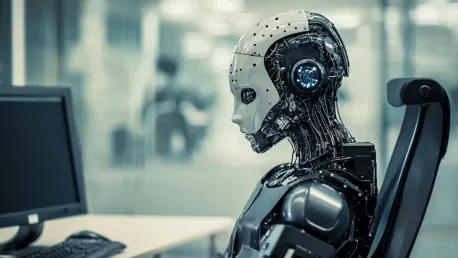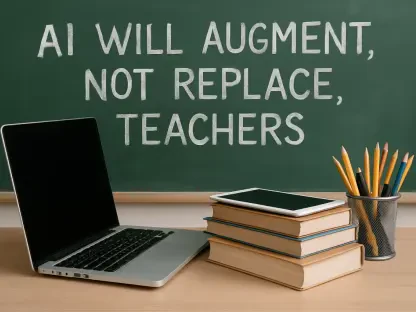Artificial Intelligence (AI) has emerged as a transformative tool in the business world, promising to revolutionize job roles and productivity. As organizations grow, they often face increasing inefficiencies due to bureaucratic processes. This article explores how AI-powered job redesign can address these inefficiencies, enhance productivity, and drive business growth.
Understanding the Impact of Bureaucratic Inefficiencies
The Growth of Bureaucracy in Expanding Organizations
As companies expand, they inevitably encounter growing bureaucratic inefficiencies that can hamper productivity. The proliferation of support and administrative roles often results in redundant tasks and decreased operational efficiency. Identifying and addressing these inefficiencies is crucial for maintaining productivity and ensuring business growth. The bureaucracy becomes more pronounced with every layer added to an organization’s hierarchy. This added complexity often results in poor communication, delayed decision-making, and an overall slowdown in operations. It’s a natural consequence of growth, but it’s not an unsolvable problem. With AI-driven tools, businesses can systematically identify these inefficiencies and propose ways to streamline them.
A growing company faces unique challenges. For instance, middle management layers often multiply, introducing new approval processes that slow down decision-making. Administrative tasks swell, leading to increased paperwork, duplication of efforts, and more bottlenecks. This is a substantial burden on both time and resources, diverting focus from core business activities. The traditional methods of handling these issues are no longer adequate. The future of combating bureaucratic inefficiencies lies in adopting AI-powered job redesign. AI can methodically analyze the work processes and highlight the pain points that need rectification. With such insightful data, companies can devise strategic plans to reduce redundancies and optimize workflows.
Challenges of Traditional Job Structures
Traditional job structures may not sufficiently support the dynamic needs of modern organizations, particularly in the face of rapid AI advancements. These outdated frameworks can restrict agility, impeding proactive responses to market demands and technological shifts. Standard hierarchical models often result in rigid roles that lack flexibility, making it difficult for employees to adapt to new technologies. AI offers a gateway to break these conventional molds and foster innovative, adaptive frameworks. The dynamic nature of AI-driven job redesign can ensure employees are aligned with the fast-paced changes occurring within businesses today.
The static nature of traditional job designs often leads to inefficiencies in task execution, misguided priorities, and a lack of innovation. Conventional structures can fail to recognize the individual strengths and capabilities of employees, resulting in underutilized potential. By embracing AI, organizations can move toward more fluid and versatile role definitions. AI empowers managers to understand the specific skills and talents within their teams, enabling them to design roles that maximize productivity and inspire creativity. Furthermore, AI-driven job analysis provides valuable insights into task management, facilitating finer decomposition and carefully eliminating redundancies. This ensures that each role within the organization is optimized for efficiency and aligned with the overall business strategy.
Harnessing AI Tools for Job Analysis
Introduction to AI-Driven Job Analysis Tools
AI tools such as Reejig, Draup, and Gloat offer groundbreaking capabilities for analyzing job roles, empowering organizations to identify inefficiencies and opportunities for optimization. By breaking down tasks into finer details, these tools help discern areas that benefit most from automation or restructuring. Reejig, for example, allows businesses to map out workforce capabilities and identify gaps, providing a path to a more efficient allocation of tasks. Similarly, Gloat’s platform utilizes AI to break down job descriptions into steps that can be analyzed, streamlined, or redesigned for better performance. These tools offer a holistic view of job roles, revealing insights that traditional methods may overlook.
Draup is another powerful AI-driven tool designed specifically for job analysis. It employs sophisticated algorithms to benchmark various roles within an organization, detailing their associated tasks and responsibilities. This in-depth analysis aids managers in understanding the intricacies of each job, ensuring that redundancies are identified and addressed. Draup’s ability to decode jobs into specific activities enables an efficient allocation of resources, allowing employees to focus on high-value tasks. By integrating these tools, companies can access unprecedented insights into their workforce, paving the way for smarter, more innovative job designs that boost overall productivity.
Real-World Applications of AI Tools
Numerous companies are already leveraging AI to streamline processes and enhance efficiency, setting a precedent for efficient job redesign. IBM, for instance, uses AI to automate various HR processes, a move that reduces bias and increases trust. The customization capabilities of AI allow IBM to sort through vast amounts of data, making unbiased decisions regarding hiring and promotion. This not only speeds up HR functions but also improves the overall quality of decision-making, enhancing employee satisfaction and workplace efficiency. IBM’s successful application of AI in HR serves as a powerful example of how technology can transform conventional operations into optimized, scalable models.
Macquarie Bank’s extensive use of Reejig illustrates another real-world application of AI in job redesign. By rationalizing customer-facing roles, Macquarie Bank has been able to centralize and automate workflows, doubling its size while maintaining operational efficiency. AI tools have facilitated the identification of roles that could be streamlined or redesigned, enabling the bank to scale up without experiencing the typical inefficiencies associated with rapid growth. Similarly, Allianz leverages a digital twin to standardize its claims process, recognizing the pivotal role such tasks play in profitability. These practical examples underscore how AI-driven tools can revolutionize job structures, ushering in enhanced productivity and efficient business models.
Strategizing AI-Driven Job Redesign
Decomposing Tasks and Centralizing Functions
A strategic approach to job redesign entails decomposing tasks into specific activities, a crucial step in optimizing job roles for enhanced productivity. By methodically breaking down roles into individual tasks, businesses can pinpoint which activities are redundant or suitable for automation. This systematic analysis reveals the intricacies of job functions, providing clear insights into which tasks can be centralized, outsourced, or restructured. Not only does this contribute to streamlined workflows, but it also frees employees from repetitive, low-value tasks, allowing them to focus on strategic, high-value activities that drive business growth.
Centralizing functions, particularly those related to routine processes, can significantly enhance operational efficiency. By creating centralized hubs for tasks such as data entry, customer inquiries, or administrative activities, businesses can eliminate repetition and improve consistency across departments. Automation plays a vital role here. AI-powered solutions can handle repetitive tasks with precision, minimizing human error and increasing productivity. This centralization and automation process not only boosts efficiency but also contributes to a more cohesive organizational structure. Employees can focus on their core responsibilities, fostering a more engaged and productive workforce.
Aligning Job Redesign with Business Goals
AI-driven job redesign must align with broader business objectives to drive growth and ensure operational efficiency. Implementing AI for job redesign should not be an end in itself; rather, it should support strategic goals such as improving customer experience, driving revenue growth, and enhancing competitiveness. This alignment ensures that technological changes are not adopted for trendiness but for concrete benefits that resonate with the company’s vision. Businesses should integrate AI thoughtfully, considering both the immediate gains in efficiency and the long-term impact on their strategic trajectory.
Effective job redesign involves a deep understanding of the organization’s business goals and the specifics of its operational dynamics. By leveraging AI to analyze tasks and processes, companies can streamline operations, reduce costs, and improve service delivery. For example, optimizing customer-facing roles using AI can vastly improve customer satisfaction and loyalty, translating into a competitive edge. Additionally, aligning AI solutions with revenue drivers ensures that productivity gains directly contribute to the bottom line. As companies focus on strategic alignment, they should also ensure robust frameworks for measuring the impact of AI integration. Continuous evaluation and adjustment will be crucial to ensure ongoing alignment with business objectives.
The Role of Work Intelligence Platforms
Benefits of Real-Time Task Analysis
Work intelligence platforms such as Reejig and Gloat provide real-time insights into task libraries, enhancing managers’ ability to identify skill gaps and redundant roles. By offering a detailed analysis of job activities, these platforms allow for the creation of optimized workflows that maintain high productivity levels. Real-time task analysis facilitates a dynamic approach to workforce management, ensuring roles and responsibilities are continuously aligned with the ever-changing organizational needs. This adaptability is key in responding to market shifts; agility requires constant recalibration of job functions, a process made seamless with AI-driven platforms.
Reejig’s platform offers unique benefits in workforce analysis by mapping out capabilities and identifying inefficiencies in real-time. This allows managers to make informed decisions about role adjustments, further enhancing productivity. For instance, a sudden increase in customer inquiries may necessitate a temporary reconfiguration of roles to ensure timely responses. Similarly, Gloat’s Mosaic platform breaks down job descriptions into precise steps, offering a granular view of necessary skills and activities. Managers can use this information to identify underutilized talents within the team and redirect them to high-impact roles. The ability to adapt immediately to new demands ensures sustained efficiency and supports long-term business growth.
Enhancing Workforce Efficiency and Value Creation
AI tools empower companies to identify and mitigate bureaucratic inefficiencies, leading to enhanced workforce efficiency. Automation allows routine tasks to be performed with greater accuracy and speed, freeing employees to concentrate on higher-value activities. This shift not only boosts productivity but also fosters innovation and creativity within the workforce. Employees can leverage their skills and knowledge on strategic initiatives, driving business growth and value creation. AI’s ability to streamline workflows and reduce administrative burden creates a more engaged and motivated workforce, positioning the company for sustained success.
The integration of AI-driven tools into everyday job functions has far-reaching implications for value creation. By automating low-value tasks, companies can unlock the time and potential of their employees, redirecting their efforts towards meaningful activities that drive innovation. Furthermore, the enhanced efficiency provided by AI contributes to a more agile and responsive organization. In times of market volatility, this agility can be a critical competitive advantage. By fostering an environment where employees are empowered to innovate and focus on strategic objectives, AI-driven job redesign contributes to both immediate productivity gains and long-term business growth.
Ensuring Employee Adaptability and Upskilling
Preparing Employees for AI-Enhanced Roles
The transition to AI-enhanced job roles must be accompanied by efforts to upskill employees, ensuring they can adapt and continue to add value. Training and development should be integral to the job redesign process, providing employees with the skills needed to thrive in an AI-driven environment. Companies must create robust training programs that focus not only on technical skills but also on strategic thinking and innovation. By investing in their workforce, businesses can ensure that AI integration supports both immediate productivity gains and long-term growth. This commitment to upskilling fosters a culture of continuous improvement and adaptability.
Preparing employees for AI-enhanced roles involves a multifaceted approach, combining hands-on training with strategic development initiatives. Continuous learning opportunities, such as workshops, online courses, and mentorship programs, can help employees gain necessary skills and confidence. Moreover, fostering an adaptive mindset is essential. Encouraging employees to embrace change and view AI as a tool for empowerment can facilitate smoother transitions. Creating a supportive environment where employees feel valued and supported in their growth ensures a successful shift to AI-enhanced roles. It also contributes to a more resilient workforce capable of navigating future technological advancements.
Long-Term Benefits of Workforce Development
Artificial Intelligence (AI) has emerged as a key tool in today’s business landscape, promising to transform job roles and improve productivity. As companies expand, they often encounter increased inefficiencies due to complex bureaucratic procedures. Many businesses are now exploring AI-powered job redesign as a solution to these challenges.
By leveraging AI, businesses can streamline their operations, reducing the time and resources wasted on redundant tasks. AI can automate routine activities, allowing employees to focus on more strategic and innovative work. This shift not only boosts productivity but also enhances job satisfaction, as employees are engaged in more meaningful and impactful tasks.
Moreover, AI can provide valuable insights through data analysis, helping businesses make informed decisions and optimize their workflows. For example, AI algorithms can analyze patterns and trends, offering recommendations for process improvements and identifying potential bottlenecks before they become problematic.
This integration of AI into job roles is driving significant business growth. Organizations are able to operate more efficiently, respond to market changes swiftly, and stay competitive in an ever-evolving landscape. As AI continues to advance, its role in business is likely to expand even further, reshaping the future of work and productivity in profound ways.
In conclusion, AI-powered job redesign is a pivotal strategy for businesses seeking to overcome bureaucratic inefficiencies and enhance overall productivity. By harnessing the power of AI, companies can unlock new levels of efficiency and drive sustainable growth.









